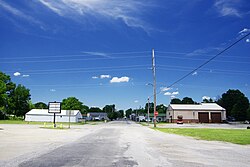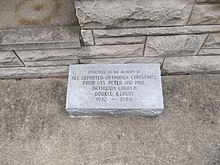Type a search term to find related articles by LIMS subject matter experts gathered from the most trusted and dynamic collaboration tools in the laboratory informatics industry.
Royalton, Illinois | |
|---|---|
 Main Street | |
 Location of Royalton in Franklin County, Illinois. | |
 Location of Illinois in the United States | |
| Coordinates: 37°52′49″N 89°6′49″W / 37.88028°N 89.11361°W | |
| Country | United States |
| State | Illinois |
| County | Franklin |
| Township | Six Mile |
| Area | |
• Total | 1.12 sq mi (2.91 km2) |
| • Land | 1.11 sq mi (2.89 km2) |
| • Water | 0.01 sq mi (0.02 km2) |
| Elevation | 390 ft (120 m) |
| Population (2020) | |
• Total | 1,068 |
| • Density | 957.85/sq mi (369.81/km2) |
| Time zone | UTC-6 (CST) |
| • Summer (DST) | UTC-5 (CDT) |
| ZIP Code(s) | 62983 |
| Area code | 618 |
| FIPS code | 17-66209 |
| GNIS feature ID | 417020[2] |
| Wikimedia Commons | Royalton, Illinois |
| Website | www |
Royalton is a village in Franklin County, Illinois, United States. The population was 1,068 at the 2020 census.[3]
According to the original surveys of Illinois, in the early 19th century the Lusk's Ferry Road ran through the middle of what is now Royalton, heading on a diagonal line toward the southeast. The Lusk's Ferry Road was an important early road connecting Fort Kaskaskia with Lusk's Ferry on the Ohio River. No trace of this road remains near Royalton. It is not clear whether the road figured in the early history of the town, or if it was long forgotten before Royalton came into existence.
Mr. Isaac Snider lived in nearby Six Mile Township in the 1850s on the Mount Vernon-Murphysboro Mail Road. Mr. Snider built a store in the spring of 1856 and opened a post office named Osage because Osage trees grew there. On November 20, 1857, Mr. Snider plotted a village of 38 lots. The hamlet soon had two stores, a post office, drug store, blacksmith shop, a doctor and a telephone exchange.[4] [5]
In 1904 Mr. Henry Pierce laid out a village just north of the mine and named it Pierce. He set up a store and moved Osage Post Office the store and the name of the village changed to Pierce. However Mr. Pierce died soon after this and he had not recorded his survey. His widow Elizabeth recorded the survey on November 3, 1905. Mr. John W. Royal owned the farm north of the Pierce farm. He had a village surveyed on his farm by September 30, 1905, and recorded that same day. As a result, the town was given the name Royalton. [5]
The village was inhabited by European immigrants related to the mining industry of the area. [6] [7]
The opening of mines in Royalton led to a population explosion, reaching a peak of 3,800 people. [4]
Royalton is located in southwestern Franklin County at 37°52′49″N 89°6′49″W / 37.88028°N 89.11361°W (37.880196, -89.113509).[8] Illinois Route 149 passes through the center of town, leading north and east 4.5 miles (7.2 km) to Zeigler and west and south 4.5 miles (7.2 km) to Hurst.
According to the 2021 census gazetteer files, Royalton has a total area of 1.12 square miles (2.90 km2), of which 1.12 square miles (2.90 km2) (or 99.29%) is land and 0.01 square miles (0.03 km2) (or 0.71%) is water.[9]
The Big Muddy and Carterville Coal Company opened the North #1 mine in 1907. It was operated by J. L. Mitchell. Mitchell bought in box cars and used them as homes for the miners. These were erected along North Main Street.[4]
Franklin Coal & Coke Company took over this mine in 1910, and along with its mine south of Royalton, operated two mines in Royalton.[10][7] At its peak, the #1 mine (sometimes also referred to as the #7 mine) employed over 600 miners. In 1949 Lyda B mine was opened however it closed in 1952.[6]
On October 22, 1914, an explosion in the North #1 Mine of the Franklin Coal & Coke Company killed 52 miners. This was the worst mine disaster to date in the coal fields of southern Illinois.[11][12] Many of the miners killed in the explosion were European immigrants [7] Another explosion occurred at the mine on September 28, 1918 killing 21 men.[13] [14]
The South Mine closed in 1920.[4] The North #1 mine operated under September, 1951. [15]
Royalton is home to the only remaining Russian Orthodox church in southern Illinois, The Protection of the Holy Virgin Mary Orthodox Church Royalton IL.[16][17][18] The church was founded by eastern European immigrants, including Rusyns,[19][17][20] [21] many of whom worked in local coal mines [22][23] The three principal founders were Frank Derbak, John August and Paul Andrews. The church opened to parishioners in late 1914.[24] It was built to mimic the construction of St. Ioasaph's in Muddy.[25]
Many of the miners who were killed in the 1914 mine disaster were members of the church.[26] There is a memorial at the church, and many of the miners were buried in a cemetery dedicated to the disaster.

At one time, there was a Russian Orthodox church in nearby Dowell, but it has closed. A memorial to the Dowell church is located in Royalton.[27]
| Census | Pop. | Note | %± |
|---|---|---|---|
| 1910 | 357 | — | |
| 1920 | 2,043 | 472.3% | |
| 1930 | 2,108 | 3.2% | |
| 1940 | 1,772 | −15.9% | |
| 1950 | 1,506 | −15.0% | |
| 1960 | 1,225 | −18.7% | |
| 1970 | 1,166 | −4.8% | |
| 1980 | 1,320 | 13.2% | |
| 1990 | 1,191 | −9.8% | |
| 2000 | 1,130 | −5.1% | |
| 2010 | 1,151 | 1.9% | |
| 2020 | 1,068 | −7.2% | |
| U.S. Decennial Census[28] | |||
As of the 2020 census[3] there were 1,068 people, 540 households, and 311 families residing in the village. The population density was 951.02 inhabitants per square mile (367.19/km2). There were 542 housing units at an average density of 482.64 per square mile (186.35/km2). The racial makeup of the village was 92.98% White, 0.56% African American, 0.00% Native American, 0.00% Asian, 0.00% Pacific Islander, 0.56% from other races, and 5.90% from two or more races. Hispanic or Latino of any race were 1.87% of the population.
There were 540 households, out of which 17.4% had children under the age of 18 living with them, 41.48% were married couples living together, 12.41% had a female householder with no husband present, and 42.41% were non-families. 34.26% of all households were made up of individuals, and 17.41% had someone living alone who was 65 years of age or older. The average household size was 2.60 and the average family size was 2.05.
The village's age distribution consisted of 13.4% under the age of 18, 6.2% from 18 to 24, 25.4% from 25 to 44, 31.5% from 45 to 64, and 23.5% who were 65 years of age or older. The median age was 49.4 years. For every 100 females, there were 101.3 males. For every 100 females age 18 and over, there were 96.5 males.
The median income for a household in the village was $33,750, and the median income for a family was $56,607. Males had a median income of $43,333 versus $20,859 for females. The per capita income for the village was $29,733. About 10.6% of families and 17.6% of the population were below the poverty line, including 25.7% of those under age 18 and 15.4% of those age 65 or over.
{{cite web}}: |last= has generic name (help)